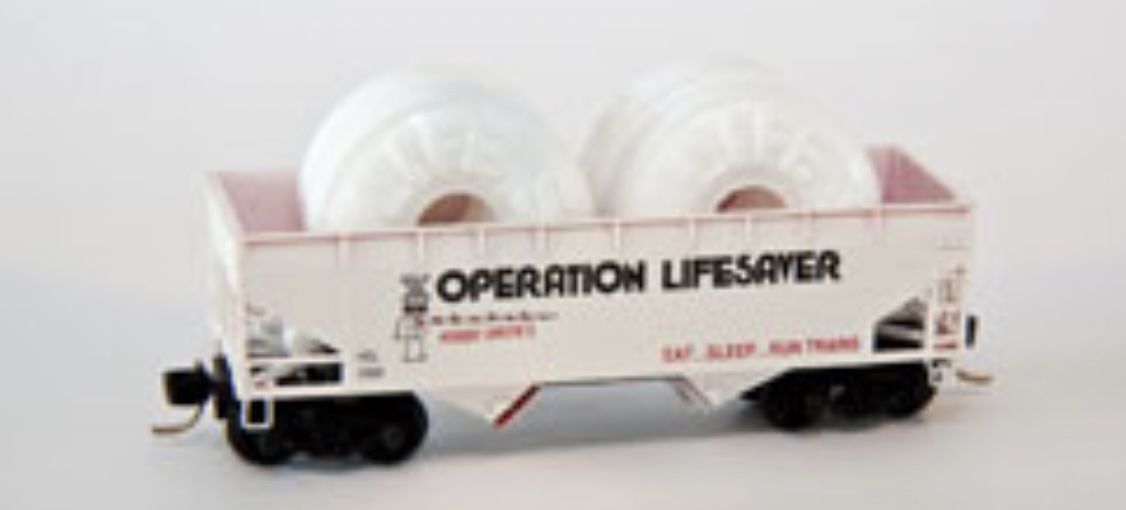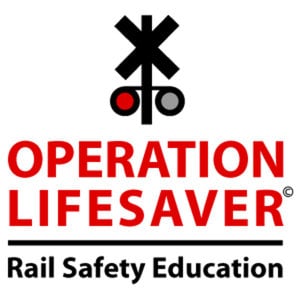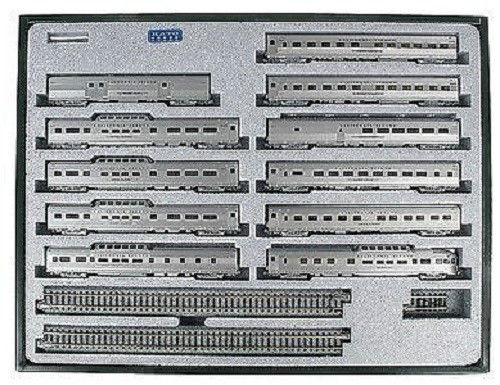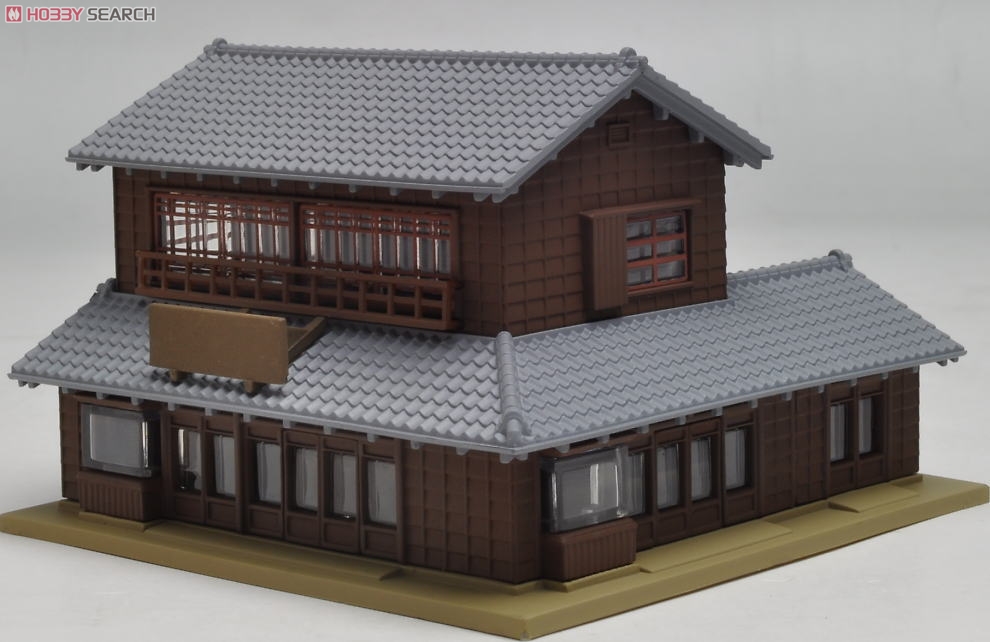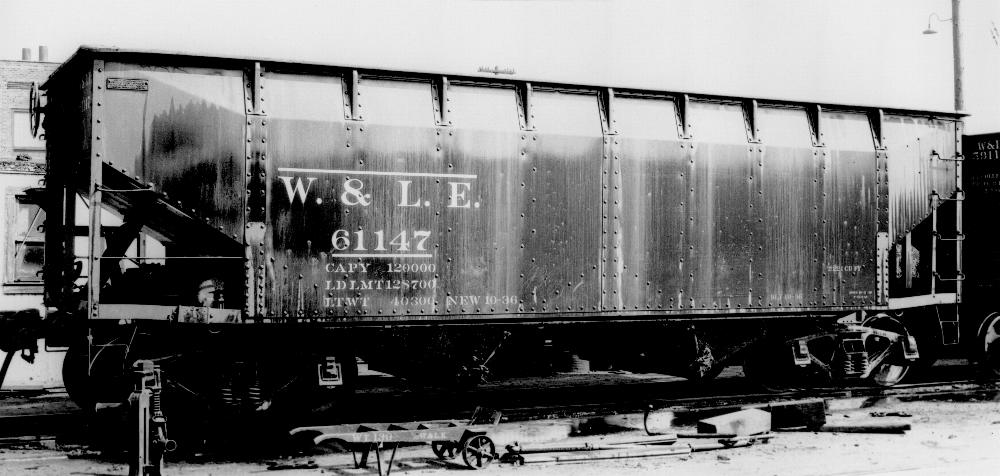Specific Item Information: 1996 Denver Convention Car - Operation Lifesaver (Road # 1996)
Model Information: The 33' Offset-Side open hopper was introduced in 1979. It is known by collectors as body style '055' or '55000 Series'. This model has been produced in over 100 different varieties since then, making it a fairly popular body style. Newer versions may come with a factory supplied load and low profile wheels.
Prototype History: The late 1920s saw the introduction of the AAR standard “offset-side” 50- and 70-ton hoppers. The design went through several variations in the late 1920s and early 1930s before settling on two versions of the 50-ton car and one 3-bay, 70-ton car in 1935. Most roads went for the AAR standard designs, but the N&W, VGN, and Pennsy were notable holdouts. World War II brought the famous “war emergency” hoppers (only the N&W and MP bought the 70-ton version) and several composite versions of existing designs. After the war, AC&F found some brief success with a welded outside-stake hopper design, but the weld joints broke under the stress of loading and unloading rather than flexing like riveted joints. The offset-side design also had problems: the inside stakes were more prone to corrosion, and they suffered worse from loading and unloading stress than outside-staked hoppers. The design waned in the 1950s and was all but abandoned for new cars by 1960. Some roads (notably the C&O, the B&O, and the L&N) made the best of a bad situation by rebuilding their offset-side cars with all new outside-staked sides in the late 1950s and early 1960s.
Road Name History:
Mission
Operation Lifesaver is a nonprofit public safety education and awareness organization dedicated to reducing collisions, fatalities and injuries at highway-rail crossings and trespassing on or near railroad tracks.
Vision
To be the recognized leader in providing the public with rail safety education and ending death and injuries due to trespassing and collisions on the tracks.
History
We started in 1972 when the average number of collisions at U.S. highway-rail grade crossings had risen above 12,000 incidents annually. To address this, the Idaho governor's office, along with the Idaho Peace Officers and Union Pacific Railroad launched a six-week public awareness educational campaign called Operation Lifesaver to promote highway-rail grade crossing safety. After Idaho's crossing-related fatalities fell that year by 43%, the successful program was adopted by Nebraska (1973) and Kansas and Georgia the following year. Within a decade it had spread around the country; in 1986 a non-profit national Operation Lifesaver office was created to help support the efforts of state OL programs and raise national awareness on highway-rail grade crossing issues.
Today Operation Lifesaver's network of authorized volunteer speakers and trained instructors offer free rail safety education programs across the U.S. We speak to school groups, driver education classes, community audiences, professional drivers, law enforcement officers, and emergency responders. Our programs are co-sponsored by federal, state and local government agencies, highway safety organizations and America's railroads. Together we promote the three E's - education, enforcement and engineering - to keep people safe around the tracks and railway crossings within our communities.
Canada
Operation Lifesaver is also present in Canada. In Canadian French, it is called Opération Gareautrain that literally reads Watch your train (Gare au train).
Mission
Operation Lifesaver is a nonprofit public safety education and awareness organization dedicated to reducing collisions, fatalities and injuries at highway-rail crossings and trespassing on or near railroad tracks.
Vision
To be the recognized leader in providing the public with rail safety education and ending death and injuries due to trespassing and collisions on the tracks.
History
We started in 1972 when the average number of collisions at U.S. highway-rail grade crossings had risen above 12,000 incidents annually. To address this, the Idaho governor's office, along with the Idaho Peace Officers and Union Pacific Railroad launched a six-week public awareness educational campaign called Operation Lifesaver to promote highway-rail grade crossing safety. After Idaho's crossing-related fatalities fell that year by 43%, the successful program was adopted by Nebraska (1973) and Kansas and Georgia the following year. Within a decade it had spread around the country; in 1986 a non-profit national Operation Lifesaver office was created to help support the efforts of state OL programs and raise national awareness on highway-rail grade crossing issues.
Today Operation Lifesaver's network of authorized volunteer speakers and trained instructors offer free rail safety education programs across the U.S. We speak to school groups, driver education classes, community audiences, professional drivers, law enforcement officers, and emergency responders. Our programs are co-sponsored by federal, state and local government agencies, highway safety organizations and America's railroads. Together we promote the three E's - education, enforcement and engineering - to keep people safe around the tracks and railway crossings within our communities.
Canada
Operation Lifesaver is also present in Canada. In Canadian French, it is called Opération Gareautrain that literally reads Watch your train (Gare au train).
Brand/Importer Information:
Desiring to bring a creative and artistic approach to model railroad cars, Lowell Smith Signature Series was born in 1994. The first special run car commemorated the Sesquicentennial (150th anniversary) of the Golden Spike - "Wedding of the Rails". Since 1994, Lowell Smith Signature Series has continued to produce over one hundred and thirty-five unique cars or train locomotives to date.
The product lines showcased in this website include creations inspired by Americana, such as the Great American Circus, American Fruit Packers and a special tribute to our Nation's National Parks. In 2008, Lowell was also asked to produce a line for the Walt Disney Company®, both at the Walt Disney Family Museum in San Francisco as well as Disneyland® Main Street USA.
Lowell Smith Signature Series continues to develop fun and innovative ideas and encourages you to join the e-newsletter updates so you can stay current on what's coming next.
The product lines showcased in this website include creations inspired by Americana, such as the Great American Circus, American Fruit Packers and a special tribute to our Nation's National Parks. In 2008, Lowell was also asked to produce a line for the Walt Disney Company®, both at the Walt Disney Family Museum in San Francisco as well as Disneyland® Main Street USA.
Lowell Smith Signature Series continues to develop fun and innovative ideas and encourages you to join the e-newsletter updates so you can stay current on what's coming next.
Manufacturer Information:  Micro-Trains Line split off from Kadee Quality Products in 1990. Kadee Quality Products originally got involved in N-Scale by producing a scaled-down version of their successful HO Magne-Matic knuckle coupler system. This coupler was superior to the ubiquitous 'Rapido' style coupler due to two primary factors: superior realistic appearance and the ability to automatically uncouple when stopped over a magnet embedded in a section of track. The success of these couplers in N-Scale quickly translated to the production of trucks, wheels and in 1972 a release of ready-to-run box cars.
Micro-Trains Line split off from Kadee Quality Products in 1990. Kadee Quality Products originally got involved in N-Scale by producing a scaled-down version of their successful HO Magne-Matic knuckle coupler system. This coupler was superior to the ubiquitous 'Rapido' style coupler due to two primary factors: superior realistic appearance and the ability to automatically uncouple when stopped over a magnet embedded in a section of track. The success of these couplers in N-Scale quickly translated to the production of trucks, wheels and in 1972 a release of ready-to-run box cars.
Micro-Trains Line Co. split off from Kadee in 1990 to form a completely independent company. For this reason, products from this company can appear with labels from both enterprises. Due to the nature of production idiosyncrasies and various random factors, the rolling stock from Micro-Trains can have all sorts of interesting variations in both their packaging as well as the products themselves. When acquiring an MTL product it is very important to understand these important production variations that can greatly enhance (or decrease) the value of your purchase.
Please consult our Micro-Trains Collector's Guide

Micro-Trains Line Co. split off from Kadee in 1990 to form a completely independent company. For this reason, products from this company can appear with labels from both enterprises. Due to the nature of production idiosyncrasies and various random factors, the rolling stock from Micro-Trains can have all sorts of interesting variations in both their packaging as well as the products themselves. When acquiring an MTL product it is very important to understand these important production variations that can greatly enhance (or decrease) the value of your purchase.
Please consult our Micro-Trains Collector's Guide
Commissioner Information:  Desiring to bring a creative and artistic approach to model railroad cars, Lowell Smith Signature Series was born in 1994. The first special run car commemorated the Sesquicentennial (150th anniversary) of the Golden Spike - "Wedding of the Rails". Since 1994, Lowell Smith Signature Series has continued to produce over one hundred and thirty-five unique cars or train locomotives to date.
Desiring to bring a creative and artistic approach to model railroad cars, Lowell Smith Signature Series was born in 1994. The first special run car commemorated the Sesquicentennial (150th anniversary) of the Golden Spike - "Wedding of the Rails". Since 1994, Lowell Smith Signature Series has continued to produce over one hundred and thirty-five unique cars or train locomotives to date.
A native of Portland, Oregon, Lowell Smith married his church choir sweetheart Barb in 1978. After a lifetime of rail-fanning, Lowell and Barb ventured out in 1992 to launch a new business in Portland, Oregon.
Following Lowell's passion of model trains, The Hobby Smith was built to be the community center for model railroaders - operators and collectors alike. Located in the Hollywood District of Portland, The Hobby Smith was the place to learn and to enjoy the camaraderie of others with the same passion.
A native of Portland, Oregon, Lowell Smith married his church choir sweetheart Barb in 1978. After a lifetime of rail-fanning, Lowell and Barb ventured out in 1992 to launch a new business in Portland, Oregon.
Following Lowell's passion of model trains, The Hobby Smith was built to be the community center for model railroaders - operators and collectors alike. Located in the Hollywood District of Portland, The Hobby Smith was the place to learn and to enjoy the camaraderie of others with the same passion.
Item created by: CNW400 on 2022-03-09 11:48:49
If you see errors or missing data in this entry, please feel free to log in and edit it. Anyone with a Gmail account can log in instantly.
If you see errors or missing data in this entry, please feel free to log in and edit it. Anyone with a Gmail account can log in instantly.


